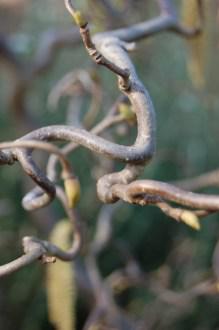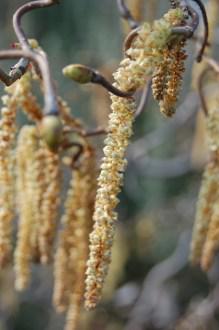
Corylus avellana 'Contorta' Stem (11/03/2012, Kew, London)
Position: Full sun to partial shade
Flowering period: Early spring
Soil: Moist, well drained
Eventual Height: 4m
Eventual Spread: 4m
Hardiness: 4a – 9a
Family: Betulaceae
Corylus avellana ‘Contorta’ is a slow growing, large deciduous shrub or a small tree. Its mid green leaves are broadly ovate, rounded, up to 12cm long, softly hairy on their upper and lower surfaces, have a double serrate margin and are often contorted. These leaves turn yellow in the autumn before leaf drop. The distinctive feature of this plant is its twisted and contorted branches. The monoecious flowers are produced before the leaves emerge and are wind pollinated catkins. The pale yellow male catkins are up to 12cm long. The female catkins are largely concealed in the buds with only the bright red long styles visible. The fruit is a nut, produced in clusters of up to 5, each nut held in a short leafy involucre.

Corylus avellana 'Contorta' (11/03/2012, Kew, London)
Corylus avellana ‘Contorta’ is commonly known as Contorted Hazel, Harry Lauder’s Walking Stick, Contorted Filbert or Corkscrew Hazel. The species Corylus avellana is native to Europe and western Asia, including the UK. The variety Corylus avellana ‘Contorta’ was discovered in a Gloucestershire (UK) hedgerow in 1862 by Canon Ellacombe of Bitton.
The etymological root of the binomial name Corylus is derived from the Latin name for the Hazel tree. Avellana is named after the town of Avella, Italy, where the Hazel was largely grown for its nuts. Contorta is derived from the Latin contortum ‘tangled’, referring to the contorted nature of the branches.
The landscape architect may find Corylus avellana ‘Contorta’ useful as an unusual specimen shrub/ small tree. It may also be valuable in a wildlife or community garden.

Corylus avellana 'Contorta' Flower (11/03/2012, Kew, London)
Ecologically, C. avellana ‘Contorta’ is attractive to squirrels and other mammals for the nuts that are produced by this plant.
C. avellana ‘Contorta’ prefers moist, fertile, well-drained soils. It tolerates most pH of soil, including chalky soils.
C. avellana ‘Contorta’ requires little maintenance.

